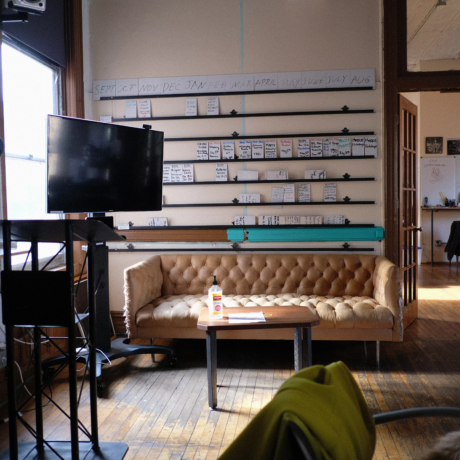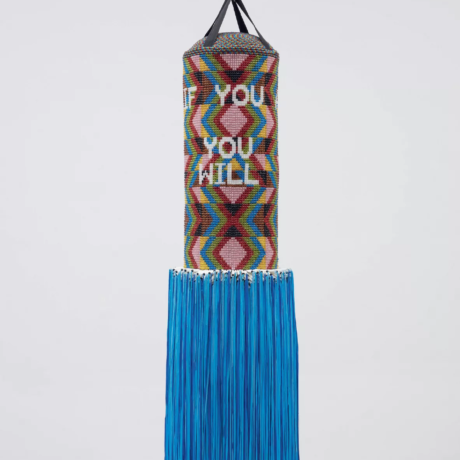
The most hated artwork to have ever exhibited in the UK might be Carl Andre’s Equivalent VIII (1966). In 1976, when the piece was exhibited at the Tate, it sparked a vitriolic public debate. The work in question—purchased by the Tate for $12,000—consists of a rectangular pile of 120 bricks, laid out in a simple stacked formation on the gallery floor.
“Forty years on, Italian artist Elisabetta Benassi wants to remind us about the artwork that made the public shit a brick.”
“Do we need toys like this at the Tate?” screamed one newspaper headline at the time. “Any way artist stacks them, bricks are bricks to British,” wrote the Chicago Sunday Times. Similar outrage and ridicule were echoed in articles, puns and satirical cartoons, but some critics, such as Richard Cork in the Evening Standard and William Packer in the Financial Times, penned support for the “matterist” sculpture. Many of these press clippings—positive and negative—were compiled by Andre himself and gifted to the Tate Archives.

Forty years on, Italian artist Elisabetta Benassi wants to remind us about the artwork that made the public shit a brick. At her newly opened exhibition It Starts with the Firing at Collezione Maramotti, Reggio Emilia, Benassi digs into the past and paves various connections between Andre’s notorious “bricks”, industry, art, contemporary ideology… and a small town in England.


The exhibition gets to you before you arrive at the gallery. Benassi has put extracts from Andre’s Tate archive up on billboards and on buses–These Bricks Could Build A Bad Reputation. Art May Come and Go But A Brick is a Brick Forever. These enigmatic aphorisms continue into the gallery, printed on paper that resembles old newsreel, with the press release for Benassi’s own show underneath the headlines in lieu of the original writing. Does Anyone Need a Pile of Bricks? A Brick is a Brick is a Brick… extracted from their context, these statements hang limply, strangely, like wet towels over their racks, pointing at the absurdity and the philosophical nature of the controversy, speculating on the value of the object: What should be considered art, and who gets to decide? How can we evaluate such a thing?
Elsewhere, Benassi plays with construction and reconstruction—both physically, and as a metaphor for how ideas are organised and dismantled. Andre’s original work, Benassi explained, was conceived to overturn Brancusi, to flatten the phallic, vertical structure of western sculpture (perhaps Andre’s feminist critics, who have protested against the American artist since he was acquitted of his wife Ana Mendieta’s death in 1988, might disagree). In Infinity, (2017) Benassi reinstates the phallus of the tower, but its erection is far from stable: the bricks teeter in a curve from floor to ceiling, threatening to collapse and crash—an anxious viewing experience.

Forging a living dialogue with history has been a consistent interest in many of Benassi’s previous works. Her bricks refer to the specific history of the site of the Collezione Maramotti, housed in the first ever Max Mara factory (the founders of the collection), with many of the industrial architectural features still visible throughout the space. An industrial press steamer is the first work you encounter (first by its smell), a machine that was used in the factory while it was still operating. It alludes to automation, machine replacing man—subtle political sentiments that allude to Andre’s open alignment with Marxism: “Matter as matter rather than matter as symbol is a conscious political position, essentially Marxist.” Like Andre, Bennassi’s matter comes from construction, manufacturing and mass-production: the new modes of production that would liberate humans, according to Marx’s theories, from labour and allow them to engage in more creative activity.
Shredded coats and gloves—designed by the Italian brand and worn by the factory workers—hang on the wall of another room. This, Benassi told Elephant on opening night, refers to the factory workers who once wore them. The artist—wearing a heavy-looking metal key around her neck given to her by one of the bricklayers who assisted her—was also struck, she said, by a comment from a guest: “il cappotto e’ il primo refugio” (“a coat is the first form of shelter.”) The solidity of brick walls as either protective or ominous is also suggested by Shadow Work, (2017), a firebrick wall in the middle of the space, eastern rugs spilling from its sides. No-one can look at such a thing and not think of Trump’s plan to seal off the Mexican border.

Benassi addresses a direct, local history at the factory, but also a history further away. She sourced the bricks for this show from Bovingdon Brickworks in the Chilterns, who produce a particular size and shape, using a unique handmade clay technique, fired in a kiln. The factory used to produce one million handmade bricks a year, but production has dwindled since they ran out of clay. It’s these kinds of layers of personal and local histories that Benassi really seems to connect to, finding art in the act of bricklaying. “The beautiful thing is that the owner of the factory [Bovingdon Brickworks] is now ninety-nine, and the firing of the bricks is essentially coming to an end with his life.”
But were “the bricks”—to come back to the artwork that inspired this exhibition—really failed ideology, or was it simply the art that failed? Many saw Andre’s minimalist sculpture as an elitist affront, rather than a Marxist statement. Benassi doesn’t attempt to answer this in her works, but uses bricks as stepping stones to other questions: when we construct walls, are we building a refuge, or shutting ourselves in, and off from each other? In one work—Zeitnot, (2017) made out of five thousand English firebricks—“you don’t know if it’s being taken down, or if it’s in the process of being built.” Benassi says, the title mixing English and German words to mean “no time.” You can walk inside the structure, only to find yourself up against a brick wall. All you can do is back out again.

Bennassi’s bricks are far more legible than Andre’s, and with her many wistful brick-based installations, they are a brilliant visual metaphor. “They still have significance today, they speak of walls, divisions, money, the problems related to housing and employment, of gentrification that pushes people from the centre of cities, like London, where the rich buy up all the houses and leave them empty.” Benassi adds. Andre’s bricks kindled a debate the likes of which was possibly only matched in intellectual vigour some twenty years later when Tracey Emin proffered her Bed as art at the Tate. This, perhaps, is what constitutes a successful artwork—to topple the walls we build in our minds.
‘It Starts with the Firing’ runs until 17 September at Collezione Maramotti. collezionemaramotti.org





